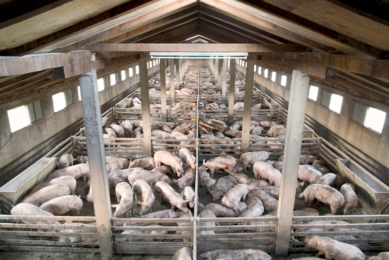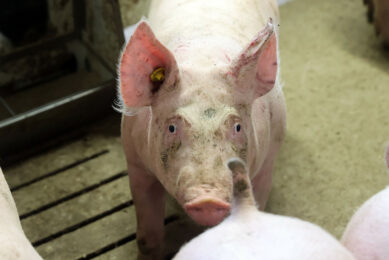China: New flu virus can jump from pigs to humans

An influenza virus, present in pigs in China since 2016, is capable of jumping to humans. Although human-to-human transmission has not been proven (yet), the virus is described as having ‘all the essential hallmarks of a candidate pandemic virus’.
The study was carried out by scientists attached to various institutes and universities around China, including the Chinese Center for Disease Control. It appeared in the US journal Proceedings of the National Academy of Sciences (PNAS). In tests, 10.4% of swine workers had tested positive for the virus – or 35 out of 338 tested persons, the authors wrote.
Close monitoring
The researchers said the virus can grow and multiply in the cells that line the human airways. As influenza viruses often mutate relatively quickly, they added that “close monitoring in human populations, especially the workers in the swine industry, should be urgently implemented”.
Any pandemic news is hot news
The news was immediately picked up by many news sites across the globe. In the context of Covid-19, any pandemic news is hot at the moment – despite the fact that experts have said this particular influenza strain does not pose an imminent threat for human health.
Pigs as mixing vessels for flu viruses
Pigs are known as ‘mixing vessels’ for influenza viruses. In their article, the Chinese researchers described the virus as ‘genotype 4 (G4) reassortant Eurasian avian-like (EA) H1N1 virus’. They said it was a recombination of the 2009 H1N1 variant which caused the ‘swine flu’ pandemic in humans in 2009.
179 swine flu viruses
The Chinese team found the ‘G4’ strain of H1N1 when it looked at influenza viruses in pigs from 2011 to 2018. In a report in the UK newspaper The Guardian, it was explained that the researchers took 30,000 nasal swabs from pigs in slaughterhouses in 10 provinces in China as well as in a veterinary hospital. In total that allowed them to isolate 179 swine flu viruses, the majority of those being of a new type of H1N1 virus that has been dominant among pigs since 2016.
Efficient infectivity and aerosol transmission in ferrets
In tests with ferrets, the G4 strain was observed to be highly infectious, replicating in human cells. In addition, the virus showed ‘efficient infectivity and aerosol transmission in ferrets’. Tests also showed that any immunity humans gain from exposure to seasonal flu does not provide protection from the G4 strain. Current influenza vaccines appear not to protect against it – yet.

Read more about pig health in the Pig Progress Health Tool
2009 H1N1 pandemic
The 2009 H1N1 variant led to the first pandemic since the Spanish flu in 1918. In hindsight it was concluded that the 2009 variety, known as ‘Mexican flu’ or ‘swine flu’, did not cause any higher risk to serious illness than seasonal flu would have had. In the ‘pandemic severity index’, the virus classified in category 1.
China closely following the developments
News agency Reuters quoted Zhao Lijian, a spokesman for China’s foreign ministry. At a news conference he said, “China is closely following the developments in regard to this matter. We will take all necessary measures to prevent the spread and outbreak of any virus.”
The article in the PNAS was authored by Honglei Sun, Yihong Xiao, Jiyu Liu, Dayan Wang, Fangtao Li, Chenxi Wang, Chong Li, Junda Zhu, Jingwei Song, Haoran Sun, Zhimin Jiang, Litao Liu, Xin Zhang, Kai Wei, Dongjun Hou, Juan Pu, Yipeng Sun, Qi Tong, Yuhai Bi, Kin-Chow Chang, Sidang Liu, George F. Gao and Jinhua Liu.











